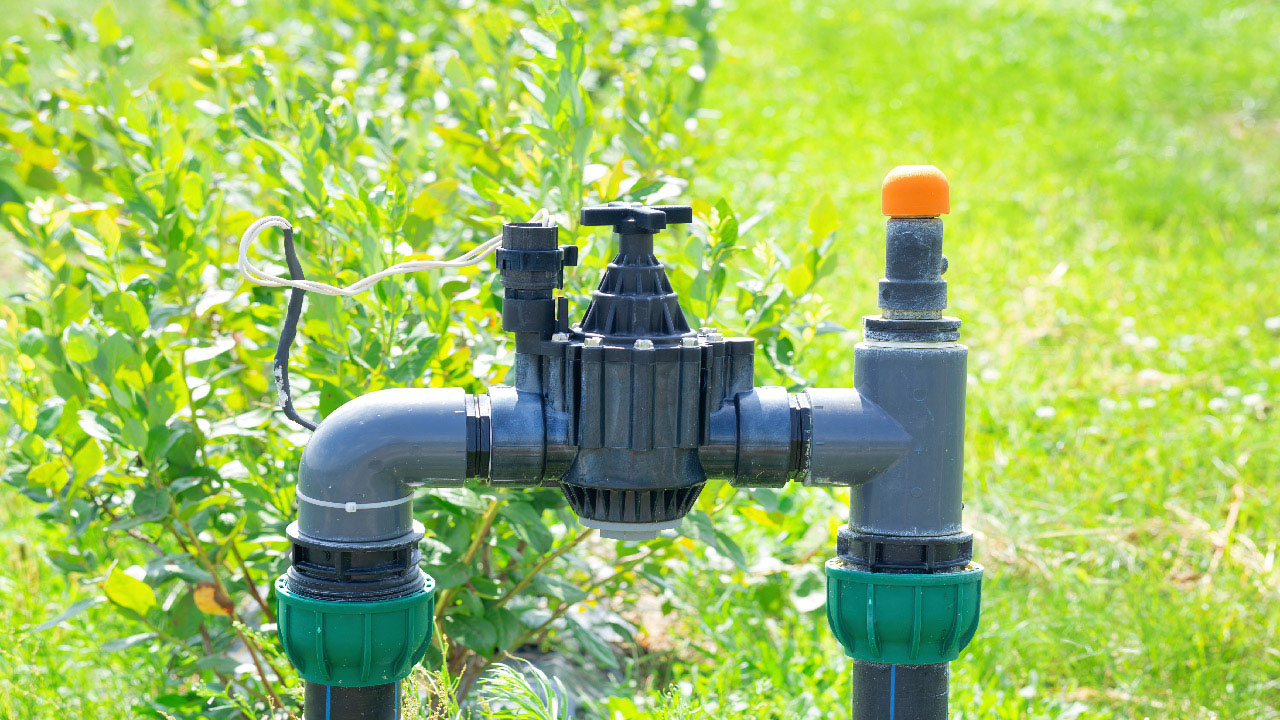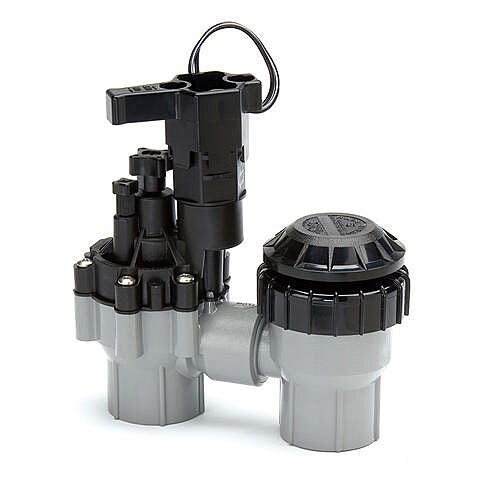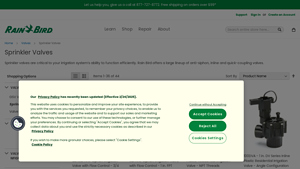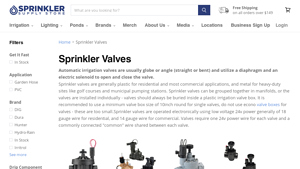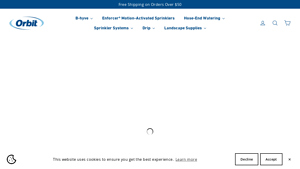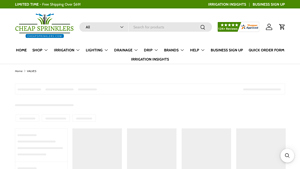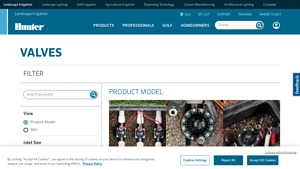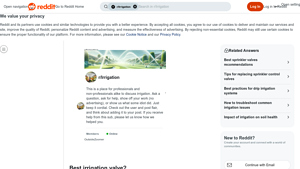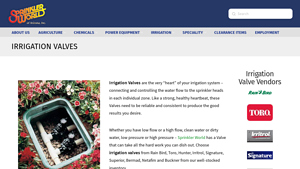Introduction: Navigating the Global Market for sprinkler irrigation valves
In the rapidly evolving landscape of agriculture and landscaping, sourcing reliable sprinkler irrigation valves is critical for optimizing water management and ensuring the efficiency of irrigation systems. International B2B buyers face the challenge of navigating diverse market offerings, varying product specifications, and fluctuating prices across different regions, particularly in Africa, South America, the Middle East, and Europe. This guide serves as a comprehensive resource, addressing key aspects such as the types of sprinkler irrigation valves, their applications, and effective supplier vetting strategies.
Buyers will explore the distinctions between automatic and manual valves, plastic versus metal materials, and the implications of these choices on system durability and maintenance. Furthermore, understanding the cost structures and potential return on investment for different valve types can significantly influence purchasing decisions. By providing actionable insights and detailed comparisons, this guide empowers international B2B buyers to make informed decisions that align with their specific irrigation needs and local market conditions.
Whether you are sourcing valves for residential projects or large-scale agricultural operations, this resource will equip you with the knowledge to enhance your procurement strategy, ensuring you select the best products for your unique requirements. With a focus on fostering efficient water use and sustainable practices, this guide is an essential tool for navigating the global market for sprinkler irrigation valves.
Understanding sprinkler irrigation valves Types and Variations
| Type Name | Key Distinguishing Features | Primary B2B Applications | Brief Pros & Cons for Buyers |
|---|---|---|---|
| Anti-Siphon Valves | Prevents backflow; integrated check valve | Residential & light commercial | Pros: Cost-effective, easy installation. Cons: Limited to low-pressure systems. |
| Inline Valves | Installed within the irrigation line; space-efficient | Commercial & industrial sites | Pros: Versatile, suitable for various setups. Cons: More complex installation. |
| Angle Valves | Designed for corner installations; space-saving design | Golf courses, parks, large gardens | Pros: Ideal for tight spaces, durable. Cons: Higher upfront cost. |
| Globe Valves | Regulates flow with a larger surface area; durable | Municipal systems, large farms | Pros: Excellent flow control, robust. Cons: Bulkier, may require more maintenance. |
| Brass Valves | Metal construction for durability; handles high pressure | Heavy-duty applications | Pros: Long-lasting, withstands extreme conditions. Cons: Expensive, heavier. |
What are Anti-Siphon Valves and Their Applications in B2B Settings?
Anti-siphon valves are vital for preventing backflow in irrigation systems. They feature an integrated check valve that helps maintain water quality by stopping contaminants from entering the water supply. These valves are primarily used in residential and light commercial applications where space is limited and simplicity is desired. B2B buyers should consider their cost-effectiveness and ease of installation, although they are typically suited for lower-pressure systems.
How Do Inline Valves Enhance Commercial and Industrial Irrigation?
Inline valves are installed directly within the irrigation line, making them an efficient choice for commercial and industrial applications. Their design allows for a compact setup, which is crucial in larger systems. Inline valves are versatile and can accommodate various configurations, making them ideal for diverse landscapes. However, their installation can be more complex, requiring skilled labor, which is an important consideration for B2B buyers looking for long-term solutions.
Why Choose Angle Valves for Golf Courses and Parks?
Angle valves are specifically designed for corner installations, making them a great choice for golf courses, parks, and large gardens. Their unique design allows them to fit into tight spaces without compromising performance. B2B buyers appreciate their durability and reliability in demanding environments, though the initial investment may be higher compared to other valve types. This makes them suitable for organizations looking for longevity and performance in their irrigation systems.
What Advantages Do Globe Valves Offer for Large-Scale Irrigation?
Globe valves are known for their ability to regulate flow effectively, making them suitable for municipal systems and large farms. They feature a larger surface area, which helps in controlling water flow more precisely. B2B buyers will find these valves robust and reliable, although they tend to be bulkier and may require more maintenance than other types. Their capability to handle high flow rates makes them a preferred choice for extensive irrigation projects.
When Should You Consider Brass Valves for Heavy-Duty Applications?
Brass valves are made of metal, providing exceptional durability and the ability to withstand high-pressure environments. They are ideal for heavy-duty applications, such as industrial irrigation systems or municipal water supply lines. While they offer longevity and resilience against extreme conditions, B2B buyers should weigh their higher costs and weight against the long-term benefits they provide in demanding applications.
Key Industrial Applications of sprinkler irrigation valves
| Industry/Sector | Specific Application of Sprinkler Irrigation Valves | Value/Benefit for the Business | Key Sourcing Considerations for this Application |
|---|---|---|---|
| Agriculture | Precision crop irrigation systems | Enhances water efficiency, reduces labor costs | Availability of durable materials, compatibility with existing systems |
| Horticulture | Greenhouse irrigation management | Promotes optimal plant growth, minimizes water wastage | Size and type of valves suitable for varied greenhouse layouts |
| Golf Course Management | Turf irrigation control | Ensures consistent turf quality, reduces water usage | Selection of heavy-duty valves for high-pressure systems |
| Municipal Water Management | Public park irrigation systems | Improves aesthetic appeal, supports local biodiversity | Compliance with local regulations, availability of maintenance support |
| Landscaping and Construction | Commercial landscape irrigation | Enhances property value, ensures sustainable water use | Customization options for unique designs, robustness for varied environments |
How Are Sprinkler Irrigation Valves Used in Agriculture?
In the agriculture sector, sprinkler irrigation valves are crucial for precision crop irrigation systems. These valves allow for controlled water delivery, ensuring that crops receive the optimal amount of moisture. This precision reduces water wastage and labor costs associated with manual irrigation methods. For international buyers, especially from regions facing water scarcity, sourcing durable valves that can withstand various climatic conditions is vital. Additionally, compatibility with existing irrigation systems should be a priority, ensuring seamless integration and operation.
What Role Do Sprinkler Irrigation Valves Play in Horticulture?
In horticulture, sprinkler irrigation valves manage water distribution in greenhouses, where maintaining optimal humidity and moisture levels is essential for plant health. These valves facilitate automated irrigation, which can be programmed to meet the specific needs of different plant species. This automation not only promotes healthier growth but also significantly reduces water usage. Buyers from regions with diverse horticultural practices should focus on the size and type of valves that align with their greenhouse layouts and plant requirements.
How Are Sprinkler Irrigation Valves Essential for Golf Course Management?
Golf courses utilize sprinkler irrigation valves for turf irrigation control, ensuring that grass remains lush and healthy throughout the year. These valves help maintain consistent turf quality while minimizing water usage, which is particularly important in areas with water restrictions. For buyers in the golf course management sector, selecting heavy-duty valves designed for high-pressure systems is crucial to withstand the demands of expansive irrigation networks. Additionally, sourcing valves that offer easy maintenance can enhance operational efficiency.
Why Are Sprinkler Irrigation Valves Important for Municipal Water Management?
Municipal water management systems employ sprinkler irrigation valves to maintain public parks and green spaces. These valves support efficient irrigation practices that enhance the aesthetic appeal of urban environments and promote local biodiversity. For B2B buyers in this sector, ensuring compliance with local regulations regarding water usage is essential. Furthermore, sourcing valves with robust maintenance support can ensure the longevity and reliability of the irrigation system.
How Do Sprinkler Irrigation Valves Benefit Landscaping and Construction Projects?
In landscaping and construction, sprinkler irrigation valves are integral to commercial landscape irrigation systems. They help ensure that newly planted areas receive adequate water, which enhances property value and promotes sustainable water use. Buyers in this sector should consider customization options for valves to accommodate unique landscape designs. Additionally, the robustness of the valves is essential to handle varied environmental conditions, ensuring long-term performance and reliability.
3 Common User Pain Points for ‘sprinkler irrigation valves’ & Their Solutions
Scenario 1: Difficulty in Sourcing Reliable Sprinkler Irrigation Valves
The Problem:
B2B buyers in regions such as Africa and South America often face challenges when sourcing reliable sprinkler irrigation valves. The market may be flooded with low-quality products that do not meet the necessary standards for durability and performance. This can lead to frequent breakdowns, resulting in costly repairs and downtime for irrigation systems. In agricultural sectors, where timing is critical for crop health, unreliable valves can jeopardize yield and profitability.
The Solution:
To overcome this sourcing challenge, buyers should prioritize working with established manufacturers that have a proven track record in the industry. Research suppliers who provide certifications or compliance with international standards, such as ISO or ASTM, which can assure product quality. Engage in direct communication with potential suppliers, requesting product samples to evaluate the quality firsthand. Additionally, consider suppliers that offer warranties and after-sales support, as this can mitigate risk and provide reassurance in case of product failure. By investing time in due diligence and building relationships with reputable suppliers, buyers can secure high-quality valves that enhance the reliability of their irrigation systems.
Scenario 2: Incompatibility with Existing Irrigation Systems
The Problem:
Another common pain point arises when B2B buyers discover that the sprinkler irrigation valves they’ve purchased are incompatible with their existing irrigation systems. This can happen due to differences in thread types, valve sizes, or pressure ratings. The result is not only wasted investment but also project delays as teams scramble to find compatible components. In regions with limited access to diverse irrigation supplies, this issue can be particularly frustrating.
The Solution:
To avoid compatibility issues, B2B buyers should conduct a thorough assessment of their current irrigation system before making any purchases. This includes taking detailed measurements of existing piping and understanding the specifications of current valves. It is advisable to maintain a comprehensive inventory list that includes sizes, types, and brands of existing components. When sourcing new valves, buyers should look for suppliers that offer customizable options or a range of fittings to accommodate various systems. Additionally, engaging with irrigation consultants can provide valuable insights into the best products that will integrate seamlessly, saving time and resources in the long run.
Scenario 3: Operational Complexity and Maintenance Challenges
The Problem:
Operational complexity and maintenance can pose significant challenges for B2B buyers managing large-scale irrigation systems. Many sprinkler irrigation valves require intricate installation procedures and regular maintenance to function optimally. In regions with harsh climates, such as the Middle East, valves are susceptible to wear and tear, leading to performance issues that can disrupt irrigation schedules and impact agricultural productivity.
The Solution:
To simplify operations and maintenance, buyers should select sprinkler irrigation valves that feature user-friendly designs and robust construction. For instance, opting for valves with built-in flow control mechanisms can reduce the need for additional components and make adjustments easier. Additionally, investing in automatic or remote-controlled valves can streamline operations, allowing for real-time monitoring and adjustments from a distance. Establishing a routine maintenance schedule is crucial; training staff on proper maintenance techniques and utilizing predictive maintenance technologies can help identify potential issues before they escalate. Providing access to comprehensive product manuals and instructional videos from manufacturers can further empower teams to manage valve performance effectively, leading to reduced downtime and increased efficiency in irrigation management.
Strategic Material Selection Guide for sprinkler irrigation valves
What Are the Key Properties of Common Materials Used in Sprinkler Irrigation Valves?
When selecting materials for sprinkler irrigation valves, it’s crucial to consider their properties, performance, and suitability for specific applications. The following analysis highlights four common materials: plastic, brass, stainless steel, and ductile iron.
How Does Plastic Compare for Sprinkler Irrigation Valves?
Plastic, particularly PVC and ABS, is widely used in residential and light commercial applications. Key properties include lightweight construction, resistance to corrosion, and a temperature rating typically between -20°F to 140°F (-29°C to 60°C).
Pros: Plastic valves are cost-effective, easy to install, and resistant to rust and corrosion, making them ideal for various water types. They also have lower manufacturing complexity, allowing for mass production.
Cons: However, they may not withstand high-pressure applications and can become brittle over time, especially in extreme temperatures. Additionally, they are less suitable for heavy-duty applications like golf courses or municipal systems.
For international buyers, compliance with standards such as ASTM and DIN is essential. In regions with high UV exposure, UV-resistant plastics should be considered to prevent degradation.
What Are the Advantages of Brass in Sprinkler Irrigation Valves?
Brass is a popular choice for its durability and strength, particularly in commercial and industrial applications. It typically offers excellent corrosion resistance and can handle higher pressure ratings, often up to 300 PSI.
Pros: Brass valves are robust, have a long lifespan, and are less prone to leaks compared to plastic. They are also compatible with a wide range of media, including reclaimed water.
Cons: The primary drawbacks include higher costs and susceptibility to dezincification in certain water conditions. They also require more complex manufacturing processes, which can lead to longer lead times.
For buyers in Europe and the Middle East, adherence to specific standards like EN and ISO is vital, especially when dealing with potable water systems.
Why Choose Stainless Steel for High-Performance Applications?
Stainless steel is renowned for its exceptional corrosion resistance and strength, making it suitable for high-performance applications, including agricultural and municipal systems. The material is capable of withstanding extreme temperatures and pressures, often rated above 300 PSI.
Pros: Stainless steel valves are durable, resistant to rust, and can handle aggressive media, making them ideal for harsh environments. Their longevity reduces the need for frequent replacements.
Cons: The primary limitation is cost, as stainless steel is significantly more expensive than plastic or brass. Additionally, the manufacturing process can be complex, resulting in longer production times.
International buyers should ensure compliance with standards like ASTM A351 or DIN 17440, particularly in regions with stringent regulations regarding materials used in irrigation systems.
What Role Does Ductile Iron Play in Heavy-Duty Applications?
Ductile iron is often used in heavy-duty applications, such as municipal water systems and large-scale agricultural projects. It offers high strength and excellent pressure ratings, typically exceeding 350 PSI.
Pros: Ductile iron valves are incredibly durable and can withstand high impact and stress, making them suitable for demanding environments. They also have excellent corrosion resistance when coated properly.
Cons: The downsides include weight, which can complicate installation and transportation. Additionally, ductile iron is more expensive than plastic and brass, and its manufacturing process can be intricate.
For international buyers, ensuring compliance with standards such as ASTM A536 is crucial, particularly in regions like Africa and South America, where infrastructure demands are high.
Summary Table of Material Selection for Sprinkler Irrigation Valves
| Material | Typical Use Case for sprinkler irrigation valves | Key Advantage | Key Disadvantage/Limitation | Relative Cost (Low/Med/High) |
|---|---|---|---|---|
| Plastic | Residential and light commercial applications | Cost-effective and corrosion-resistant | Limited pressure rating | Low |
| Brass | Commercial and industrial applications | Durable and leak-resistant | Higher cost and dezincification risk | Med |
| Stainless Steel | High-performance agricultural and municipal systems | Exceptional corrosion resistance | High cost and complex manufacturing | High |
| Ductile Iron | Heavy-duty municipal and agricultural projects | High strength and impact resistance | Heavy and more expensive | Med |
This guide provides actionable insights for international B2B buyers, aiding in the strategic selection of materials for sprinkler irrigation valves based on performance, application suitability, and compliance with regional standards.
In-depth Look: Manufacturing Processes and Quality Assurance for sprinkler irrigation valves
What Are the Key Stages in the Manufacturing Process of Sprinkler Irrigation Valves?
The manufacturing process of sprinkler irrigation valves involves several critical stages, each essential for ensuring quality and functionality. The main stages include material preparation, forming, assembly, and finishing.
How Is Material Prepared for Sprinkler Irrigation Valve Manufacturing?
Material preparation is the first step in the manufacturing process. Common materials used for sprinkler valves include high-density polyethylene (HDPE), brass, and PVC. Manufacturers begin by sourcing these materials from reputable suppliers, ensuring they meet international quality standards. The materials are then subjected to rigorous quality checks, including visual inspections and material testing for properties such as tensile strength and corrosion resistance.
What Techniques Are Used in Forming Sprinkler Irrigation Valves?
Forming techniques vary depending on the material used. For plastic valves, injection molding is the primary technique employed. This method allows for precise shaping of components, ensuring uniformity and reducing waste. For metal valves, processes such as die casting or CNC machining are prevalent. These techniques enable manufacturers to create complex geometries that enhance the valve’s functionality and durability.
How Are Sprinkler Irrigation Valves Assembled?
After the components are formed, they move to the assembly stage. This process involves combining various parts, such as the valve body, diaphragm, solenoid, and any additional components like flow control mechanisms. Assembly is often done manually or with semi-automated equipment, ensuring that each valve meets design specifications. Quality control checks are implemented during assembly to verify proper fit and functionality.
What Finishing Processes Are Applied to Sprinkler Irrigation Valves?
Finishing processes enhance the appearance and functionality of the valves. Common finishing techniques include surface treatments like coating, polishing, or plating, particularly for metal valves to prevent corrosion. Plastic valves may undergo UV stabilization processes to enhance their durability against sunlight exposure. Each finishing step is critical in prolonging the life of the valves and ensuring they operate efficiently in various environmental conditions.
What Quality Assurance Practices Are Commonly Implemented?
Quality assurance (QA) is paramount in the manufacturing of sprinkler irrigation valves. Manufacturers often adhere to international quality standards such as ISO 9001, which outlines criteria for a quality management system. Compliance with these standards demonstrates a commitment to quality and continuous improvement.
How Do International Standards Like ISO 9001 Impact Quality Assurance?
ISO 9001 certification requires manufacturers to establish a systematic approach to quality management. This includes defining quality objectives, processes, and responsibilities. Regular audits are conducted to ensure compliance, and corrective actions are implemented for any identified non-conformities. This framework not only improves product quality but also builds trust among B2B buyers.
What Are the Key Quality Control Checkpoints in the Manufacturing Process?
Quality control (QC) checkpoints are strategically placed throughout the manufacturing process to ensure that each stage meets predefined standards. These checkpoints typically include:
- Incoming Quality Control (IQC): This involves inspecting raw materials upon receipt to ensure they meet specifications before processing begins.
- In-Process Quality Control (IPQC): During manufacturing, periodic checks are performed to monitor the quality of components being formed and assembled.
- Final Quality Control (FQC): Once the valves are fully assembled, they undergo rigorous testing to ensure they function correctly under various conditions.
What Common Testing Methods Are Used for Sprinkler Irrigation Valves?
Manufacturers employ various testing methods to validate the performance and durability of sprinkler irrigation valves. Common tests include:
- Pressure Testing: Valves are subjected to pressure tests to ensure they can withstand operational pressures without leaking.
- Flow Testing: This assesses the valve’s ability to control water flow effectively.
- Cycle Testing: Valves are cycled on and off to simulate long-term use, ensuring that components like solenoids and diaphragms perform reliably over time.
How Can B2B Buyers Verify Supplier Quality Control?
For international B2B buyers, verifying a supplier’s quality control practices is essential. Buyers can take several steps to ensure the supplier adheres to rigorous standards:
Conduct Supplier Audits: Regular audits of the manufacturing facility can provide insights into the quality management systems in place and the adherence to international standards.
Request Quality Reports: Suppliers should provide documentation detailing their quality control processes, testing methods, and any certifications obtained.
Engage Third-Party Inspectors: Independent inspectors can be hired to assess the quality of products during and after manufacturing, ensuring compliance with the agreed specifications.
What Nuances Should International Buyers Consider in Quality Control?
When sourcing sprinkler irrigation valves from manufacturers in different regions, buyers should be aware of the varying quality standards and practices. For instance, suppliers in Europe may have stringent regulations compared to those in Africa or South America. Understanding these differences is crucial for ensuring product quality.
Additionally, buyers should consider the logistics of shipping and handling, as these factors can affect the product’s quality upon arrival. It’s advisable to discuss packaging standards with suppliers to minimize damage during transportation.
Conclusion
The manufacturing processes and quality assurance practices for sprinkler irrigation valves are intricate and critical to ensuring product reliability and performance. By understanding these processes and implementing thorough verification methods, international B2B buyers can make informed decisions that lead to successful partnerships and quality outcomes. Investing time in evaluating suppliers based on their manufacturing capabilities and quality control practices will ultimately pay dividends in the long run.
Practical Sourcing Guide: A Step-by-Step Checklist for ‘sprinkler irrigation valves’
In this practical sourcing guide, we aim to assist B2B buyers in effectively procuring sprinkler irrigation valves. This checklist covers essential steps that will help you make informed decisions, ensuring you select the right products and suppliers for your irrigation needs.
Step 1: Define Your Technical Specifications
Understanding your technical requirements is the foundation of a successful procurement process. Identify the type of sprinkler valves you need—such as globe, angle, anti-siphon, or inline—and specify the size and material (plastic or metal) based on your application. Consider factors like flow rate, pressure rating, and compatibility with existing systems.
Step 2: Research Reputable Suppliers
Finding reliable suppliers is crucial for ensuring quality and service. Investigate suppliers’ backgrounds, looking for established companies with a proven track record in the irrigation industry. Check online reviews, testimonials, and their presence in relevant trade associations or networks to gauge their reputation.
Step 3: Evaluate Potential Suppliers
Before committing, it’s vital to vet suppliers thoroughly. Request company profiles, case studies, and references from buyers in a similar industry or region. Assess their customer service responsiveness and support capabilities, as these factors can significantly impact your experience and satisfaction.
Step 4: Verify Product Certifications and Compliance
Ensure that the products meet local and international standards for safety and performance. Check for certifications such as ISO, CE, or relevant agricultural standards in your region. Compliance with these standards not only guarantees quality but also reduces the risk of installation issues or operational failures.
Step 5: Request Samples or Demonstrations
Whenever possible, request samples or product demonstrations before placing a large order. This allows you to assess the quality, functionality, and compatibility of the valves with your irrigation system. Evaluating a sample can reveal important insights about the product that specifications alone may not convey.
Step 6: Negotiate Terms and Conditions
Once you’ve identified potential suppliers, engage in discussions about pricing, payment terms, and delivery schedules. Negotiating favorable terms can lead to better pricing and more flexible payment options, which is crucial for managing cash flow, especially in large projects. Be clear about your expectations regarding lead times and after-sales support.
Step 7: Plan for Long-Term Support and Maintenance
Consider the long-term implications of your procurement decisions. Evaluate suppliers based on their ability to provide ongoing support, replacement parts, and maintenance services. A supplier that offers comprehensive after-sales service can significantly enhance the longevity and efficiency of your irrigation system.
By following these steps, B2B buyers can streamline their procurement process for sprinkler irrigation valves, ensuring they make informed choices that align with their operational needs and objectives.
Comprehensive Cost and Pricing Analysis for sprinkler irrigation valves Sourcing
What Are the Key Cost Components in Sprinkler Irrigation Valves?
When sourcing sprinkler irrigation valves, understanding the cost structure is essential for B2B buyers. The main cost components include materials, labor, manufacturing overhead, tooling, quality control (QC), logistics, and margin.
Materials: The choice of materials significantly impacts cost. Plastic valves are generally more affordable and suited for residential and light commercial applications, while metal valves, which are typically used in heavy-duty contexts such as municipal irrigation, come at a higher price point due to the cost of raw materials.
Labor and Manufacturing Overhead: Labor costs can vary based on the location of the manufacturing facility. Countries with lower labor costs may offer competitive pricing, but it’s crucial to consider the trade-offs in terms of quality and reliability. Manufacturing overhead includes expenses related to factory operations, which can also fluctuate based on geographical factors.
Tooling: This is a critical one-time investment for manufacturers, particularly when producing custom valves. High-quality tooling can improve production efficiency and product consistency, but it also adds to the upfront costs.
Quality Control: Implementing rigorous QC measures ensures that valves meet performance standards and certifications. This can add to costs but ultimately protects buyers from future expenses related to product failures.
Logistics: Shipping costs, including freight and insurance, can vary widely based on the supplier’s location and the chosen Incoterms. International shipping can further complicate logistics with tariffs and customs duties.
Margin: Suppliers typically add a profit margin to cover their costs and generate profit. This margin can vary based on the supplier’s market positioning and competitive landscape.
How Do Price Influencers Affect Sprinkler Irrigation Valve Pricing?
Several factors influence the pricing of sprinkler irrigation valves, including volume or minimum order quantities (MOQ), specifications or customization, materials used, quality certifications, supplier characteristics, and Incoterms.
Volume/MOQ: Purchasing in bulk can lead to significant discounts. Suppliers often have set minimum order quantities, and exceeding these can result in lower per-unit costs.
Specifications and Customization: Custom valves tailored to specific applications will generally incur higher costs due to additional design and manufacturing complexity.
Materials and Quality Certifications: Valves made from higher-quality materials or those that meet specific industry certifications (e.g., NSF, ISO) are priced higher. Buyers should weigh the benefits of these certifications against their project requirements.
Supplier Factors: The supplier’s reputation, reliability, and service capabilities can also influence pricing. Established suppliers may charge a premium for their proven quality and customer service.
Incoterms: Understanding Incoterms is crucial for international buyers, as they determine who is responsible for shipping costs, insurance, and customs clearance. Selecting the right Incoterm can impact the total landed cost.
What Buyer Tips Can Help Optimize Costs for Sprinkler Irrigation Valves?
B2B buyers can employ several strategies to enhance cost-efficiency when sourcing sprinkler irrigation valves:
Negotiation: Engage in discussions with suppliers to explore bulk discounts, flexible payment terms, or additional value-added services.
Total Cost of Ownership (TCO): Consider not only the purchase price but also long-term operational costs, including maintenance, potential downtime, and energy consumption. A lower-priced valve may not be the most cost-effective option if it has a shorter lifespan.
Pricing Nuances for International Buyers: Buyers from regions like Africa, South America, the Middle East, and Europe must consider currency fluctuations, local market conditions, and regional tariffs. Establishing relationships with local distributors can also provide insights into market pricing and trends.
Conclusion
Understanding the comprehensive cost structure and pricing dynamics of sprinkler irrigation valves is vital for international B2B buyers. By being aware of the various cost components, price influencers, and strategic tips, buyers can make informed decisions that align with their budget and project requirements. Note that prices mentioned in this analysis are indicative and can fluctuate based on market conditions and supplier negotiations.
Alternatives Analysis: Comparing sprinkler irrigation valves With Other Solutions
Introduction to Alternative Solutions for Irrigation
When selecting an irrigation system, businesses must consider various alternatives to traditional sprinkler irrigation valves. This analysis will explore two viable alternatives: drip irrigation systems and surface irrigation methods. Each solution presents unique advantages and challenges that can significantly influence operational efficiency and cost-effectiveness for agricultural and landscaping needs.
| Comparison Aspect | Sprinkler Irrigation Valves | Drip Irrigation Systems | Surface Irrigation Methods |
|---|---|---|---|
| Performance | Excellent for large areas and varied terrain; uniform coverage | Highly efficient in water usage; minimizes evaporation | Effective for flat terrains; relies on gravity for distribution |
| Cost | Moderate initial investment; long-term durability | Higher initial setup costs; lower operational costs over time | Low initial costs; potential for high maintenance expenses |
| Ease of Implementation | Requires specialized knowledge for installation | Installation can be labor-intensive; requires careful planning | Simple to implement; minimal technical expertise required |
| Maintenance | Moderate; periodic checks and replacements needed | Low; mainly involves checking emitters for blockages | High; requires regular maintenance to prevent clogging and soil erosion |
| Best Use Case | Large-scale farms, golf courses, and residential areas | Vegetable gardens, orchards, and high-value crops | Flood-prone areas, rice paddies, and low-lying regions |
Detailed Breakdown of Alternatives
Drip Irrigation Systems
Drip irrigation is a method that delivers water directly to the plant roots through a network of tubing and emitters. This system offers significant water savings, making it ideal for regions where water conservation is critical. The precision of water application minimizes weed growth and reduces disease incidence. However, the initial costs can be higher due to the need for specialized equipment and installation labor. The labor-intensive setup may deter some buyers, but the long-term savings in water and energy costs can justify the investment.
Surface Irrigation Methods
Surface irrigation involves the distribution of water over the soil surface through gravity. This method is straightforward and cost-effective, particularly for flat terrains where water can be easily channeled. It is commonly used in crops like rice, where fields can be flooded. The simplicity of this method requires minimal technical expertise for setup. However, surface irrigation can lead to uneven water distribution, increased evaporation losses, and soil erosion if not managed properly. Regular maintenance is essential to prevent blockages and ensure effective operation.
Conclusion: Choosing the Right Irrigation Solution
When deciding on an irrigation system, B2B buyers should carefully evaluate their specific requirements, including the type of crops, terrain, water availability, and budget constraints. Sprinkler irrigation valves provide a reliable option for diverse landscapes, while drip systems offer superior water efficiency for high-value crops. Surface irrigation may be ideal for certain geographical conditions but comes with higher maintenance demands. A thorough analysis of these factors will enable buyers to select the most suitable irrigation solution tailored to their operational needs and long-term goals.
Essential Technical Properties and Trade Terminology for sprinkler irrigation valves
What Are the Key Technical Properties of Sprinkler Irrigation Valves?
Sprinkler irrigation valves are essential components that control water flow in irrigation systems. Understanding their technical specifications is crucial for making informed purchasing decisions. Here are some critical properties to consider:
1. Material Grade
Sprinkler valves are typically made from materials such as plastic or metal. Plastic valves are common for residential and light commercial use, while metal valves are preferred for heavy-duty applications, like municipal systems or golf courses. The choice of material affects durability, resistance to corrosion, and cost. For international buyers, selecting the appropriate material grade can significantly impact the longevity and efficiency of the irrigation system.
2. Pressure Rating
The pressure rating, measured in PSI (pounds per square inch), indicates the maximum pressure the valve can withstand. A higher pressure rating is essential for systems that require significant water flow or operate in high-pressure environments. Understanding pressure requirements helps ensure that the chosen valve can handle the operational demands, reducing the risk of failure and costly repairs.
3. Flow Rate
Flow rate, typically measured in gallons per minute (GPM), determines how much water can pass through the valve. Selecting a valve with the right flow rate is crucial for meeting the irrigation needs of a specific area. An inadequate flow rate can lead to under-irrigation, while excessive flow can cause water waste and system damage. Buyers should calculate the required flow rate based on the size of the irrigation zone to ensure optimal performance.
4. Electrical Specifications
Sprinkler valves often operate using low voltage (commonly 24V), making electrical specifications critical. The gauge of the wire used (such as 14 or 18 gauge) affects the efficiency and reliability of the valve’s operation. B2B buyers must consider compatibility with existing electrical systems, especially in regions with varying voltage standards.
5. Diaphragm and Solenoid Design
The diaphragm and solenoid are vital components that control the valve’s opening and closing mechanism. Diaphragm design impacts how quickly and efficiently the valve responds to electrical signals. Understanding these components can help buyers select valves that offer faster response times and better reliability, which is especially important in automated irrigation systems.
What Are Common Trade Terms Related to Sprinkler Irrigation Valves?
Familiarity with industry terminology can streamline communication and negotiations. Here are some key terms to know:
1. OEM (Original Equipment Manufacturer)
An OEM refers to a company that produces components that are used in another company’s end products. For buyers, purchasing from reputable OEMs ensures that the valves meet industry standards and specifications, providing reliability and performance.
2. MOQ (Minimum Order Quantity)
MOQ is the smallest quantity of a product that a supplier is willing to sell. Understanding MOQ is essential for B2B buyers, especially when budgeting for initial purchases. This can affect inventory management and cash flow, particularly in regions with fluctuating demand.
3. RFQ (Request for Quotation)
An RFQ is a document sent to suppliers to request pricing and terms for specific products. Submitting an RFQ allows buyers to compare different suppliers’ offers, ensuring they secure the best deal. This process is critical for making informed purchasing decisions, especially in competitive markets.
4. Incoterms (International Commercial Terms)
Incoterms are standardized terms used in international trade to define the responsibilities of buyers and sellers. Familiarity with these terms helps B2B buyers understand shipping, insurance, and customs responsibilities, reducing the risk of unexpected costs or delays.
5. Valve Manifold
A valve manifold is a system that groups multiple valves together, allowing for more efficient control of multiple irrigation zones. For buyers, understanding the benefits of valve manifolds can lead to better system design and potentially lower installation costs.
By understanding these technical properties and trade terms, international buyers can make more informed decisions when purchasing sprinkler irrigation valves, leading to enhanced operational efficiency and cost-effectiveness in their irrigation systems.
Navigating Market Dynamics and Sourcing Trends in the sprinkler irrigation valves Sector
What Are the Current Market Dynamics and Key Trends in the Sprinkler Irrigation Valves Sector?
The global market for sprinkler irrigation valves is being driven by several factors, including the increasing demand for efficient water management solutions, particularly in regions prone to drought, such as parts of Africa and the Middle East. As agricultural practices evolve, there is a notable shift towards automation and precision irrigation, which enhances water conservation and boosts crop yields. The incorporation of smart technology—such as IoT-enabled valves and remote monitoring systems—has also emerged as a key trend, allowing farmers and commercial buyers to optimize irrigation schedules based on real-time data.
Moreover, international B2B buyers are increasingly prioritizing suppliers that offer comprehensive support services, including installation and maintenance. The trend towards consolidation in the supply chain is noteworthy, as larger companies often acquire smaller manufacturers to expand their product offerings and improve logistics. In markets like South America and Europe, sustainability is driving innovations in valve design, with a focus on materials that reduce environmental impact. As buyers seek out reliable suppliers, understanding regional preferences and regulatory frameworks becomes crucial for successful sourcing.
How Is Sustainability and Ethical Sourcing Influencing the Sprinkler Irrigation Valves Market?
Sustainability has become a critical consideration in the procurement of sprinkler irrigation valves. B2B buyers are increasingly aware of the environmental impacts of their sourcing decisions, particularly in agriculture, where water management plays a vital role in ecosystem preservation. Ethical sourcing practices are gaining traction, with buyers looking for manufacturers who adhere to responsible labor practices and sustainable material sourcing.
The use of “green” certifications and materials is becoming a standard expectation. Buyers should seek suppliers that provide transparent information regarding the sustainability of their products, including certifications from recognized bodies. Innovations in valve manufacturing processes that reduce waste and energy consumption are also important. By prioritizing these aspects, international buyers not only contribute to environmental conservation but also enhance their brand reputation in an increasingly eco-conscious market.
How Has the Sprinkler Irrigation Valves Sector Evolved Over Time?
The evolution of the sprinkler irrigation valves sector can be traced back to the early days of agricultural irrigation, where simple mechanical valves were used to control water flow. Over the decades, advancements in materials—transitioning from brass and steel to more durable plastics—have led to the development of valves that are lighter, corrosion-resistant, and easier to install.
The introduction of automation in the 1980s marked a significant turning point, as electric and solenoid-operated valves began to replace manual systems, offering enhanced control and efficiency. Today, smart irrigation technologies that integrate with digital platforms are revolutionizing the sector, allowing for unprecedented precision in water management. This historical context underlines the importance of continuous innovation in meeting the evolving needs of B2B buyers in diverse markets.
Frequently Asked Questions (FAQs) for B2B Buyers of sprinkler irrigation valves
1. How do I select the right sprinkler irrigation valves for my project?
Choosing the right sprinkler irrigation valves involves assessing your specific irrigation needs. Consider factors such as the type of plants being irrigated, the size of the area, and the water pressure available. Additionally, evaluate whether you need automatic valves for efficient water management or manual options for simpler systems. Look for valves with appropriate materials (plastic for residential and lightweight applications; metal for heavy-duty use) and ensure compatibility with your existing system components.2. What is the best type of valve for efficient irrigation management?
For efficient irrigation management, anti-siphon valves are often recommended as they prevent backflow and protect your water source from contamination. Inline valves, which are designed for specific layout configurations, can also provide flexibility in larger systems. Ultimately, the choice depends on your system’s design, the required flow rate, and environmental conditions. Consult with suppliers or experts to determine the most suitable valve type based on your operational requirements.3. What are the common materials used in sprinkler irrigation valves?
Sprinkler irrigation valves are typically made from two primary materials: plastic and metal. Plastic valves are lightweight, corrosion-resistant, and ideal for residential or light commercial applications. Metal valves, often made from brass or stainless steel, are better suited for heavy-duty environments such as golf courses or municipal systems where durability and pressure resistance are critical. When sourcing valves, consider the environmental conditions to choose the best material for longevity and performance.4. How do I vet suppliers for sprinkler irrigation valves?
To effectively vet suppliers, start by researching their reputation in the industry. Look for reviews, testimonials, and case studies from previous clients. Verify their certifications and adherence to international standards, especially if sourcing from different regions. Establish clear communication and ask for samples or product catalogs to assess quality. Additionally, inquire about their experience in exporting to your region, which can indicate their ability to navigate local regulations and logistics.5. What is the minimum order quantity (MOQ) for sprinkler irrigation valves?
Minimum order quantities (MOQs) can vary widely among suppliers, often depending on the type of valve and the supplier’s production capabilities. Typically, MOQs can range from a few dozen for standard models to several hundred for specialized valves. When negotiating, clarify your needs and ask about flexibility in order sizes, especially if you’re testing new products or entering a new market. Understanding the MOQ will help you manage your inventory and cash flow effectively.6. What payment terms should I expect when purchasing irrigation valves internationally?
Payment terms can vary significantly based on supplier policies and the nature of your business relationship. Common terms include advance payment, letters of credit, or payment upon delivery. It’s advisable to negotiate terms that provide you with security while ensuring the supplier can maintain cash flow. Always confirm the currency of payment and any additional costs such as shipping or customs duties that may affect the total price.7. How can I ensure quality assurance for the sprinkler irrigation valves I purchase?
To ensure quality assurance, request product specifications and certifications from suppliers. Establish clear quality control standards and consider third-party inspections before shipment. If possible, visit the manufacturing facility or engage with suppliers who can provide detailed documentation on their quality assurance processes. Additionally, consider trial orders to assess the product performance before committing to larger purchases.8. What logistics considerations should I keep in mind when importing sprinkler irrigation valves?
When importing valves, consider shipping methods, lead times, and customs regulations specific to your country. Evaluate the total landed cost, which includes shipping, insurance, and tariffs, to avoid unexpected expenses. Work with logistics partners who have experience in handling agricultural equipment to ensure compliance with local regulations and timely delivery. Proper planning can help streamline the import process and mitigate potential delays or issues.
Important Disclaimer & Terms of Use
⚠️ Important Disclaimer
The information provided in this guide, including content regarding manufacturers, technical specifications, and market analysis, is for informational and educational purposes only. It does not constitute professional procurement advice, financial advice, or legal advice.
While we have made every effort to ensure the accuracy and timeliness of the information, we are not responsible for any errors, omissions, or outdated information. Market conditions, company details, and technical standards are subject to change.
B2B buyers must conduct their own independent and thorough due diligence before making any purchasing decisions. This includes contacting suppliers directly, verifying certifications, requesting samples, and seeking professional consultation. The risk of relying on any information in this guide is borne solely by the reader.
Top 7 Sprinkler Irrigation Valves Manufacturers & Suppliers List
1. Rain Bird – Sprinkler Valves
Domain: store.rainbird.com
Registered: 1995 (30 years)
Introduction: This company, Rain Bird – Sprinkler Valves, is a notable entity in the market. For specific product details, it is recommended to visit their website directly.
2. Sprinkler Supply Store – Automatic Irrigation Valves
Domain: sprinklersupplystore.com
Registered: 2010 (15 years)
Introduction: This company, Sprinkler Supply Store – Automatic Irrigation Valves, is a notable entity in the market. For specific product details, it is recommended to visit their website directly.
3. Orbit – Top Underground Valves for Sprinkler and Drip Systems
Domain: orbitonline.com
Registered: 1999 (26 years)
Introduction: Top Underground Valves for Sprinkler and Drip Systems
4. Cheap Sprinklers – Irrigation Valves
Domain: cheapsprinklers.com
Registered: 2014 (11 years)
Introduction: Cheap Sprinklers offers a wide range of irrigation valves including residential and commercial options. The types of valves available include electronic solenoid valves, indexing valves, clean water valves, dirty water valves, low-pressure valves, high-pressure valves, foot valves, and flow sensor valves. Brands featured include K-Rain, Hunter, Rain Bird, and Weathermatic.
5. Hunter – Irrigation Solutions
Domain: hunterirrigation.com
Registered: 2001 (24 years)
Introduction: {“products”:[{“model”:”1″},{“model”:”1½”},{“model”:”2″},{“model”:”ICV”},{“model”:”IBV”},{“model”:”PGV-ASV”},{“model”:”Accu Sync®”},{“model”:”Quick Couplers”},{“model”:”Wireless Valve Link”},{“model”:”Drip Control Zone Kits”},{“model”:”PGV Jar-Top”}],”inlet_sizes”:[“¾”,”1″,”1¼”,”1½”,”2″,”3″],”features”:[“Smart Technology”,”Remote Control Compatible”],”application_types”:[“Low Flow”,”Medium Flow”,”H…
6. RainBird – 1 Valve & Hunter – PGVs
Domain: reddit.com
Registered: 2005 (20 years)
Introduction: Preferred brands: RainBird, Hunter. Recommended models: 1″ Rainbird, Hunter PGVs, Hunter DVFs. Key features: Universal solenoids for Hunter valves, easy disassembly with hex and Philips screws, flow control recommended for residential use.
7. Sprinkler World – Irrigation Valves
Domain: sprinklerworld.com
Registered: 1997 (28 years)
Introduction: Irrigation Valves are essential components of irrigation systems, responsible for connecting and controlling water flow to sprinkler heads in individual zones. They are designed to be reliable and consistent, accommodating various conditions such as low or high flow, clean or dirty water, and low or high pressure. Sprinkler World offers a range of irrigation valves from reputable brands including …
Strategic Sourcing Conclusion and Outlook for sprinkler irrigation valves
In the evolving landscape of irrigation technology, effective strategic sourcing of sprinkler irrigation valves has become paramount for B2B buyers. By understanding the diverse range of products available—ranging from residential plastic valves to robust commercial metal options—buyers can better align their procurement strategies with their specific operational needs. Emphasizing quality, compatibility, and supplier reliability ensures that organizations can maintain efficient irrigation systems that optimize water usage and enhance agricultural productivity.
Moreover, the growing demand for advanced irrigation solutions in regions such as Africa, South America, the Middle East, and Europe highlights the importance of sourcing valves that meet local environmental conditions and regulatory standards. Buyers should leverage partnerships with reputable manufacturers and suppliers to access innovative technologies and competitive pricing, further driving value in their operations.
Looking ahead, as global agricultural practices increasingly prioritize sustainability and efficiency, the role of reliable sprinkler irrigation valves will only grow. It is crucial for international B2B buyers to stay informed about market trends and emerging technologies. Engage with suppliers today to explore tailored solutions that can elevate your irrigation strategies and drive long-term success in your agricultural endeavors.

